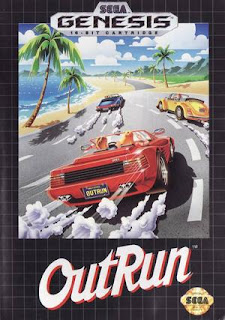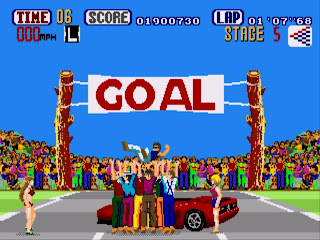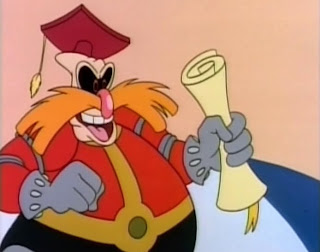
Why is everyone burning out their tires?
The 1980's was a time before Street Figther 2 and its many imitators dominated arcades. Companies were racing to create the next big sensation to eat people's spare quarters. Because of this the arcades of the time were a showcase for incredible graphics and enticing gimmicks that home consoles like the NES could never dream of being able to emulate. Unlike today arcades were where you went for eye-candy and ground-breaking games. It's difficult for some people these days to grasp how big a deal it was for the Sega Genesis to deliver unabridged versions arcade hits on a home platform. Before the Genesis it was just accepted that the arcade and home experiences were two different things.

Time to sit back, relax and drive like a maniac.
Sega's most famous arcade branch AM2 and its exceptional designer Yu Suzuki are known for creating classic after classic in during that decade and their success continues well into the present. Using clever programming tricks they designed some of the most visually impressive games of their day. Hang-On, Space Harrier, After Burner and our subject for today, OutRun used what they called "Super-Scaler" technology that created a simple pseudo-3D effect at extremely high frame rates. These games were also some of the first 16-bit arcade games and not only did they look incredible compared to their counterparts but they played fast and fun. Some of the arcade cabinet gimmicks they used included a motorcycle frame to sit on and steer through leaning in Hang-On and the interior of a car with unheard of force-feedback that moved the entire machine with the deluxe cabinet of OutRun. If nothing else these attractions would draw your attention away from the usual stand-up cabinets and force you to notice them.

Switching on some tunes with my weird looking hand.
Many cut-down versions of Sega's arcade hits ended up on their Master System and a few of them even went over to their competitor's unstoppably popular NES as well as a few computers of the time. Needless to say when Sega would release their 16-bit home system, the Genesis, far more arcade accurate versions of these games would be released for it.
OutRun is in many ways a follow up to the earlier motorcycle racing game Hang-On though it differs in many ways. Both games made an excellent conversion to the Genesis which had more than enough horsepower to do them justice even though the scaling isn't quite as foolproof as it is in the arcades. Both games used the "Super-Scaler" technology to great effect creating interesting atmospheres with believable speed and cool effects like hills. It's something we might take for granted today but the elevation changes were a big innovation for driving games which used to be limited to driving on flat surfaces. The illusion of movement is created by scaling sprites from small to large towards the player making them look like they're coming at you while the road would use alternating strips of dark and light colors to give the illusion that you're driving over it. It was ingeniously simple and effective and it gave these games an unprecedented sense of speed.

People sure are excited to see me break every traffic law on the book.
Like Hang-On, OutRun is a race to the finish against the clock. Instead of a sport bike you're a guy driving with his girlfriend in a generic red sports car that has been popularly recognized as a convertible Ferrari Testarossa. Called the Testarossa Spider, in reality there is only one legitimate convertible variant of this car in existence though unofficial Spider modifications have been done.
Unlike it's motorcycle cousin you're not really racing against anyone else in particular and are just trying to get from point-A to point-B as quickly as possible. It's a simple premise that isn't as boring as you would think and the nature of the game always reminded me of speed-driving movies like Smokey and the Bandit and Cannonball Run. Instead of other racers you have to contend with traffic which comes in a small assortment of different cars and gives you the feeling that you're driving on real roads instead of a race track. Yu Suzuki himself once said that he doesn't consider OutRun a racing game, but a driving game.

Cool sailboats.
Another innovation that set this game apart from the competition and added to the idea that you were driving along on actual roadways were the forks before each checkpoint. You could choose to go either left or right and depending on which path you took you'd end up in a new environment. In comparison Hang-On and most other racing titles of the time had you driving on a predetermined track. This was an excellent feature that added to the longevity of the otherwise short arcade gameplay. After you beat one route you wanted to play again to see what you missed on the other routes. The different stages were attractive to look at and switching them up kept the experience from growing stale. One moment you could be driving on a sunny beach then you would move on to a scenic mountain road or possibly end up in the desert where the roads are unpaved or on a snowy highway. Am2 even upped the ante by giving the game multiple endings depending on which paths you decided to take.

Suddenly we're in ancient Rome or something.
Other than the 3D effects the rest of the graphics were highly detailed. The Ferrari you drive was lovingly recreated right down to the prancing horse logo and the people inside are fully visible and look great. In Hang-On when you crash you fall off of your bike while in OutRun if you hit an obstacle on the side of the road hard enough you'll either spin out and get told off by your girlfriend or be sent flying out of your car as it tumbles end-over-end down the highway. It's a nice touch that along with some of the goofy endings adds to the humor and overall laid-back feel of the game. Other little things that you'd notice if they weren't there like your break-lights and smoking tires really put the game over the top in the detail department for a title this old. I have only one minor gripe with the graphics; because the obstacles on the side of the road are being repetitively scaled to convey the sense of speed they're very repetitious carbon copies of each other. It's not so bad with objects like trees and billboards but sometimes stuff like an army of identical boat shops is a little weird. As I said earlier the scaling is not quite as good as the arcade game and it can be a little choppy at times.

Note: A Ferrari is not built for desert driving.
The game has very simple controls with A-button to break, B-button to accelerate and C-Button to shift gears between low and high. It's archaic by today's standards but the driving is smooth and entertaining regardless. Much of the fun has to do with the atmosphere because even though you're on a timer something about the game just makes it feel relaxed. It's like going out for a leisurely drive (like a maniac in a super-sports car) without actually going out for a drive. The car controls flawlessly with the Sega Genesis controller even though it's not quite the same experience you'd get from the steering wheel in the arcade. Unlike Hang-On's Genesis port, Super Hang-On, OutRun seems to be a straight arcade port with no additional gaming modes though you have the option to adjust the difficulty.
The only sound-effect that really stands out in my mind is the tire-screeching which can get annoying. The music on the other-hand is superb. The Genesis version comes with all three selectable tracks from the arcade original and a bonus fourth track that really rocks. Memorable soundtracks really add a lot of character to simple games like this and OutRun's is very memorable.

I knew I should have brought a map.
This game might not turn many heads today but it's an arcade classic that set the standard for driving games in its day. It's still a blast to play today and that's saying something because typically I'm not a fan of racing games. It's got a lot of character to it that elevates it beyond the generic. It doesn't take very long to drive through the game and once you've seen everything, you've seen everything so some people might not get a lot of replay-value out of this one. Personally I find it to be one of those games, like many arcade titles, that you can play again and again simply because the gameplay itself is so enjoyable.

Shrugging off a 170 MPH crash.
As I discussed earlier OutRun was ported to several other systems as well and even had a second 3D glasses version for the Master System though the Genesis version is probably the most arcade-perfect. It also recieved three of what Yu Suzuki has termed "unofficial" sequels on the Genesis; the Japan only Turbo OutRun, the futuristic OutRun 2019 and OutRunners. They were good games in their own right but failed to recapture the charm of the original. The franchise has stayed alive and has seen a few modern remakes such as its official sequel OutRun 2 and OutRun 2006: Coast 2 Coast, this time with official Ferrari licensing.

The map of our very diverse neighborhood.
OutRun is ultimately less a game about race driving and more a game about luxury and relaxation as you fly an expensive sports car through beautiful locales with your girl by your side. It's 1980's escapism at its finest.

Moments before they drop me on my spine and end my racing career.
Scoring:
Presentation: 9 The feeling of freedom on the open road while you enjoy the excesses of an expensive Italian sports car and a hot babe helps to elevate OutRun from a simple driving game to a timeless classic. The funny endings and lots of other little details really show the care that Sega put in their old arcade titles. It only loses a point for being a little choppier than the arcade version.
Gameplay: 9 I would give it a perfect ten for its tight controls and excellent sensation of speed but the game is just a little too short considering you reach the end in around six minutes. You've only got the normal arcade mode so it won't take you long to see it all. There's nothing more to it than driving from beginning to end but thankfully that's such an enjoyable experience that it doesn't matter much. The game is fine as it is but I can't help but feel they should have included something more like they did with Super Hang-On's original mode. It was common for arcade ports to have extra modes but apparently Sega felt this one stood up fine on its own.
Graphics: 8 While it's really close to the arcade some of the colors have been dulled a bit, yet the game still remains exceptionally colorful for an earlier Genesis title. The Genesis also can't handle the sprite scaling as well as the arcade hardware though it's as close to an arcade perfect port as you're going to get on the console and is a big improvement over the earlier Master System port.
Sound: 9 The music is one of the things that OutRun will be forever remembered for. All of the tracks are catchy and memorable. It's some of the best classic video game music of all time and it sounds incredible on the Genesis. The only problem I have is that the somewhat annoying tire-screeches distract from the wonderful tunes.
Lasting Appeal: 8 Like most of the arcade classics it's got a simple and addictive concept that's fun to pick up and play for a few minutes. It's not the type of game that you'll sit down and play all day then beat and never pick up again. It's the type of game that you'll have the urge to play for a few minutes every once in a while that never gets old. You'll always be trying to shave a few seconds off your time.
Overall Average: 8.6/10
Recommendations:
Collector: Out of all of the arcade ports that helped cement the popularity of the Genesis this is probably one of the best. It's a real Sega classic and I've never met a Sega fan who disliked OutRun. As far as I'm concerned it's a must have for any Genesis collection. It's one of the first in a long line of stellar Sega arcade racers.
Gamer: If you like racing games this one may be a little odd to you at first and possibly seem a little too simplistic. Give it a shot and once you get into the atmosphere and the casual feel of the gameplay you might start to understand what makes it so enjoyable.











































